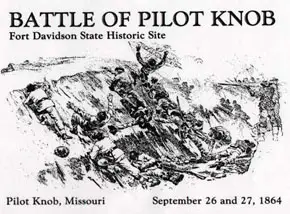Civil War Battles |
Colonial Wars |
American Wars |
Link To This Page — Contact Us —
The Battle of Pilot Knob
September 26-27, 1864 in Iron County, Missouri
Price's Missouri Campaign
Union Forces Commanded by:
Brig. Gen. Thomas Ewing, Jr.
Confederate Forces Commanded by: Maj. Gen. Sterling Price
**Missing and Captured Conclusion: Union Victory |
 |
BATTLE SUMMARY
In September, a Confederate army under Maj. Gen. Sterling Price crossed into Missouri with the goal of capturing St. Louis. Price, heading north toward St. Louis, received word at Fredericktown of Union positions. Spies told him that 8,000 troops were encamped near St. Louis and ready to defend the city. He was also told that a garrison of 1,500 Union troops were at the nearby town of Pilot Knob. Price saw the chance of an easy victory.On September 26, he sent Gen. Shelby northward to destroy the tracks and bridges of the Iron Mountain Railroad, cutting off the Union force at Pilot Knob from St. Louis reinforcements. The rest of Price's army marched toward Pilot Knob until late in the afternoon when they collided with Federals at a spot called Shut-In Gap, near the town of Arcadia, where indecisive skirmishing took place until darkness fell. During the day, Brig. Gen. Thomas Ewing moved with reinforcements down the railroad to Ironton to retard Price's advance.
On September 27, the struggle resumed with the Federals fighting a delaying action through Ironton to Pilot Knob where their commander, Brig. Gen. Thomas Ewing, ordered his men to take up positions at Fort Davidson. Surrounded by a dry moat 10-feet wide and over 6-feet deep, the fort was an 8-sided structure with a 9-foot high dirt parapet topped with sandbags. An impressive network of trenches beyond its walls provided the fort with outer defenses. Ewing's force was not 1,500 strong as reported to Price, but actually consisted of no more than 900 men, some of whom were civilian volunteers from the vicinity. However, with 4 huge siege guns, 3 howitzers, 3 mortars, and 6 field artillery pieces, Ewing's men prepared to hold the fort against the thousands of Confederates massing before them.
That afternoon, after a short and pitifully ineffective bombardment of the fort by 4 cannons situated on high ground, Price ordered an assault. The high-pitched "Rebel Yell" echoed through the valley as thousands of men hurled themselves into a hideous storm of shot and shell. Three times they charged the walls; 3 times they failed to take them. The hellish gunfire mowed down scores of soldiers. A few reached the moat, only to be slaughtered by rifle fire and crude grenades. As the thunder of the guns finally subsided, thick clouds of sulfureous gunsmoke drifted away to reveal a ghastly scene of carnage.
The fields before Fort Davidson were covered with nearly 1,000 dead and wounded men. The surviving Confederates bivouacked for the night and prepared to renew the bloody contest in the morning, building ladders to scale the fort's walls. Word that the hated Ewing was in command of the Union force no doubt strengthened the resolve of the Confederates. Price, considering the possible time involved, had dismissed the possibility of mounting guns on the high ground to compel the fort to surrender or to shell the garrison into submission.
Inside the fort, Ewing tallied up his casualties, only 75, and made plans to attempt an evacuation that night. Incredibly, he succeeded. At 3:00 A.M., his troops quietly slipped out of the fort, and in the nighttime chaos of battle preparations, the Union force was mistaken by Confederate pickets for friendly troops moving to a new position. An hour after the Federals abandoned the fort, a slow burning fuse in the powder magazine accomplished its mission, setting off an incredible explosion that shook the surrounding hills and left a huge smoldering crater in the middle of the fort. Not taking a hint, the Confederates believed an accident had occurred within the stronghold and that the survivors would surrender at dawn.
Price learned that the fort was his but that Ewing and his men were gone. A subsequent attempt by a portion of the Confederate force to overtake the Federals was unsuccessful. There was no victory for the Confederates to celebrate at Pilot Knob and large numbers of troops began deserting the Army of Missouri soon after the bloody debacle.
